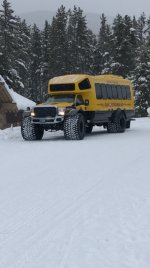Texasmark
Elite Member
- Joined
- Apr 24, 2012
- Messages
- 3,738
- Location
- N. Texas
- Tractor
- Ford: '88 3910 Series II, '80 3600, '65 3000; '07 6530C Branson with FEL, 2020 LS MT225S. Case-IH 395 and 895 with cab. All Diesels
I can really agree that volume doesn't matter because you are compressing the molecules.
Pressure and volume are inversely proportional to
each other. This means that as the pressure
decreases, the volume increases, and as the pressure
increases, the volume decreases. One way to think
of this is if you push on a gas by decreasing its
volume, it pushes back by increasing its pressure.
Interested in more comments.
I proved this on my motorcycle air bags that replaced my lawn mower springs.
I had a gauge on the bag. Set pressure was 5psig. I got on the seat and sat down and the pressure went up since the volume went down with me sitting on a soft bag. I recorded the pressure change. Then I bounced up and down on the seat which increased the pressure in spikes to a higher value because I decreased the volume more.
I then attached a tank to the system with a volume about 10x the previous volume. Set it to 5psig again. Did the same senario. Pressure variations were about 1/10 what they were previously.
On tractor tires in my stuff, I want a soft ride so I set them as low as I can considering the application. On my filled tires I play with the numbers on each machine till I am satisfied. It becomes a toss up of how much air volume do I leave with my fill (the weight of which helps to keep the tires on the ground and smooth over bumps better) vs how much pressure differential is my back going to feel when I hit a bump and the pressure spikes.
Another way of looking at it is that if you fill the tire to 100% liquid at the recommended pressure the tire will act like a solid object since the liquid doesn't compress and the tire is fully inflated. You could replace it with a wooden wheel essentially.
So, I fill to where the fluid is even with the valve stem which is about 10 or 2 O'Clock position on the mounted tire wheel assy. Then I set to the suitable minimum pressure the application will allow. This works good for me. My p/u truck runs at the rated 35 psig with no fluid fill. It has a soft ride by design and besides it has those babby sitters that squeal at you if you drop below a certain pressure.

